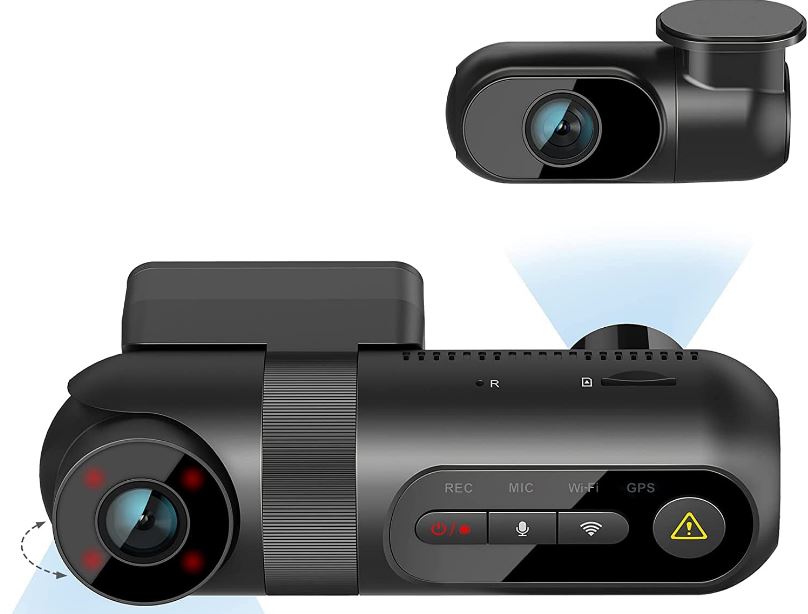
VIOFO T130 3 Channel Dash Cam
About VIOFO
Since its founding in 2011, VIOFO has established itself as one of the world’s leading makers of dashcams that are dependable, innovative, interactive, and of the highest caliber. The VIOFO dashcam performs admirably thanks to its high-quality video resolution, covert design, and sophisticated features.
Since the majority of dash cams on the market in 2011 had an internal battery that could not be safely used while the camera was heating up, VIOFO released the first supercapacitor dash cam, the G1W-C. At the time, dash cams were also fairly large and used a large suction mount that was very noticeable. Thus, we created the tiny hidden wedge dashcam A118C in 2013. As soon as wedge dash cams hit the market, they became very well-liked, and we continued to enhance the products with the newest technology.
For example, we increased the video resolution from Full HD to Quad HD and 4K UHD, supported dual-channel front and rear camera recording, used the built-in GPS logger rather than an external GPS module, and added Wi-Fi and Bluetooth connectivity.
Product Overview
Standard Items

Optional Accessories

Product Diagram
- Front Camera (Main Unit)


- GPS Module
- Reset Hole
- microSD Card Slot
- Front Rotatable Lens
- Interior Rotatable Lens
- Power On | OFF Recording Start | Stop
- Microphone On | OFF
- Wi-Fi On | OFF
- Video Protect
- Rear Camera Port
- Power In / microSD Card Reader Mode (computer)
- Recording Status Indicator
- Microphone Status Indicator
- Wi-Fi Status Indicator
- GPS Status Indicator
- Heat-dissipation Block (Don’t touch this block)
- Rear Camera (Optional)

LED Indicators

Buttons and Icons

Installation
Insert / Remove the Memory Card
- Insert the memory card
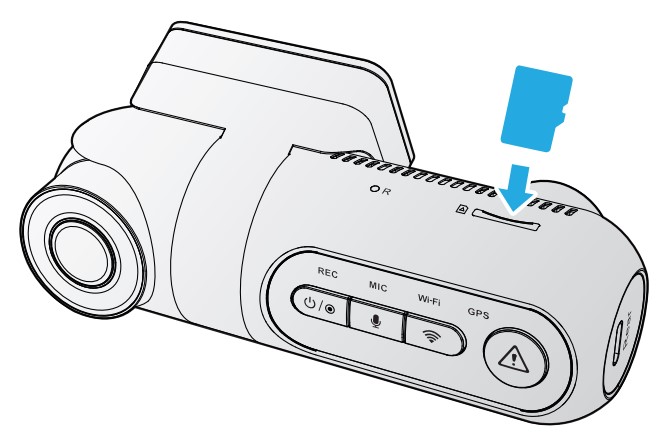
Make sure the metal contacts on the memory card are facing away from the VIOFO logo side of the main unit. Ensure the camera is turned off and push the memory card into the card slot until you hear a click.
- Remove the memory card
Ensure that the camera is turned off, and then push the edge of the memory card with your fingernail. The card will spring out far enough to be removed.
Note:
- The microSD card is sold separately. The microSD card must have a UHS-U1/U3 or above rating and a capacity of up to 256GB.
- We recommend you buy the VIOFO brand memory cards which are manufactured with top-tier MLC NAND flash, making them durable and reliable.
- Please format the card on a computer to the exFAT or FAT32 file system.
- Formatting will permanently erase any data on the microSD card. For best performance, format periodically (after backing up any important files).
- Make sure the metal contacts on the memory card are facing away from the VIOFO logo side of the main unit. Ensure the camera is turned off and push the memory card into the card slot until you hear a click.
- Please turn off the T130 before inserting or removing the microSD card.
- Inserting or removing the microSD card while recording may destroy the files.
- Format the memory card
Format the memory card in the camera
To format the card in the camera, either use the VIOFO App and the format option in Settings or long-press the button.
Format the memory card using a computer
To format the memory card on your computer, follow your computer’s user manual.
For deep formatting of the memory card, you can also download the GUIFormat tool from our official website: https://support.viofo.com/support/solutions/folders/19000019360
Install Front Camera
- Install the mount
- Insert the clips, then slide the mount horizontally into the slot on the back of the camera.
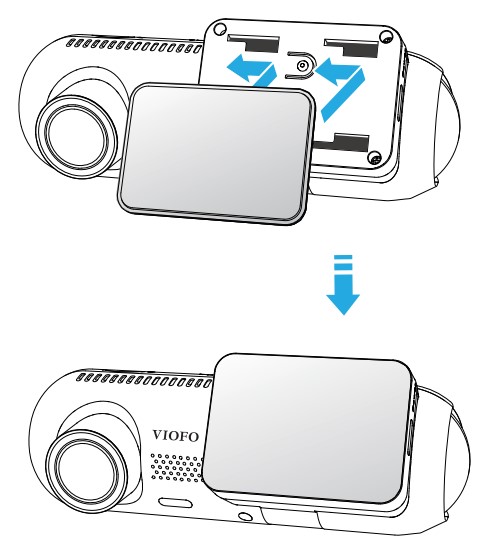
- Select a location on the windshield behind the rear-view mirror where the camera will not obstruct the driver’s view while driving.
- Wipe clean the installation surface of the windscreen with a dry cloth, it must be grease-free for the sticky pad to stick firmly.
- Peel the protection film off the sticky pad and camera lens.
- Fix the front camera on the selected location.
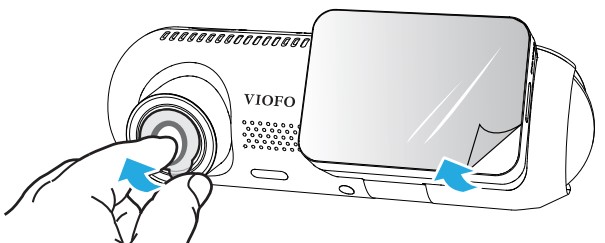
- Adjust the lens angle
Adjust the angle of the lens up / down if required. The Interior Rotatable Lens can also be rotated left and right.
Never try to rotate the lens completely. Cameras destroyed by too much rotation of the lens are out of warranty. - Connecting to Power.
Plug the USB power adapter into your vehicle’s 12V / 24V female power socket. Insert the car charger USB cable’s male port into the camera mount’s USB Type-C port.
- Select a location on the windshield behind the rear-view mirror.

Install Rear Camera (Optional)
- Select an installation location.
- Wipe clean the installation surface of the windscreen with a dry cloth.
Select a location on the windscreen, without defrost grid wires, and where the camera can record the entire rear view. - Peel the protection film OFF the sticky pad and camera lens.

- Fix the rear camera on the selected location.
- Connecting with Rear Camera.
Power off the product and connect the rear camera cable to the front camera (main unit). Cable routing should be as shown in the following two diagrams. Use the cable clips to help fix the two cables conveniently and safely.


Remove Cameras
- Remove the front camera
To remove the front camera from its bracket, slide the camera to the right and pull the front camera out of the mounting bracket.
Note: When you want to plug and unplug the front camera or rear camera, please turn off the camera first.
- Remove the rear camera
Unplug the rear camera cable from the rear camera port and remove the entire mount from the glass.
Tips
- Do not install/mount the camera in a location that interferes with the driver’s visibility and safety.
- Install/mount the camera close to the rearview mirror so that both sides of the scene being recorded are equally covered by the camera’s FOV (field of view).
- To ensure a clear view on rainy days, the lens should be positioned within the windshield wiper’s sweeping range.
- Do not install/mount the camera on or near airbag panels.
- Installation / mounting location should not be affected by sun control film (window tint). There should not be any other electronic equipment close to the camera for optimal performance.
Note:
Do not install/mount the camera or cables near an airbag panel or within the airbag’s working range. The manufacturer is not liable for any injury or death caused by the deployment of the airbag.
Dash Cam Recording Operation
Power On/Off
- When you start the engine, the camera will turn on and begin recording automatically.
- When you turn off the engine or unplug the charging cable from the power adapter, the camera will stop recording and turn off.
- Long press the button to power on or off the camera.
Loop Recording
- Insert a microSD card into the camera’s card slot and automatic loop recording will begin once the camera detects power.
- The time frame for each video file is 1 / 2 / 3 / 5 / 10 minutes.
- When there is insufficient space on the MicroSD card, loop recording will automatically overwrite the oldest files (one by one).
- Loop recording files are saved to SD card: \ DCIM \ MOVIE folder.
Emergency Recording
- Automatic emergency recording
When the G-sensor is activated and a collision occurs, current footage will be locked automatically to avoid being overwritten by loop recording. - Manual emergency recording
Pressing the button during footage recording will lock the current footage to avoid being overwritten by loop recording.
Note:
The collision sensing feature can be adjusted in settings under the “G-sensor” option via the VIOFO App. Locked files are saved to an SD card: DCIM \ Movie \ RO
Disable / Enable Audio Recording
Pressing the button once to turn off / on audio recording, the LED light will be off / solid Red.
Parking Mode
There are three options for parking mode.
- Auto Event Detection
The camera will automatically record a video sequence while a moving object is being detected during parking mode. It will stop recording when no new movement is detected. - Time Lapse Recording
Time-lapse records a video at low frames at 1 / 2 / 3 / 5 / 10 fps, it keeps recording continuously without audio recorded. Note: Audio cannot be recorded in time-lapse mode. - Low Bitrate Recording
This mode records both video and audio using a low bitrate for front, interior, and rear views. It records continuously using a small file size
Note: Parking mode provides surveillance of your parked vehicle only when the engine is off and the USB Type-C Hardwire Kit is used to provide continuous power. The Hardwire Kit also protects your car battery from being drained. We recommend buying the VIOFO HK4 ACC hardwire kit cable for parking mode recording.
Play and Manage Videos
Playback Video on the VIOFO APP
Long press the Wi-Fi button to enable Wi-Fi. Connect Wi-Fi on your phone first. Open the VIOFO app and choose “Connect your camera” to use your phone to control the dashcam. You can play and manage files through the APP. You can check the app introduction by referring to [Review and Control on Smartphone].
Playback Video on PC
- Remove the memory card from the dashcam.
Before removing the memory card, make sure you have switched off the Dashcam. - Insert the memory card into a memory card reader connected to your PC.
- Open the DCIM folder, using VLC or another video player to playback the video.
Video File Storage Location
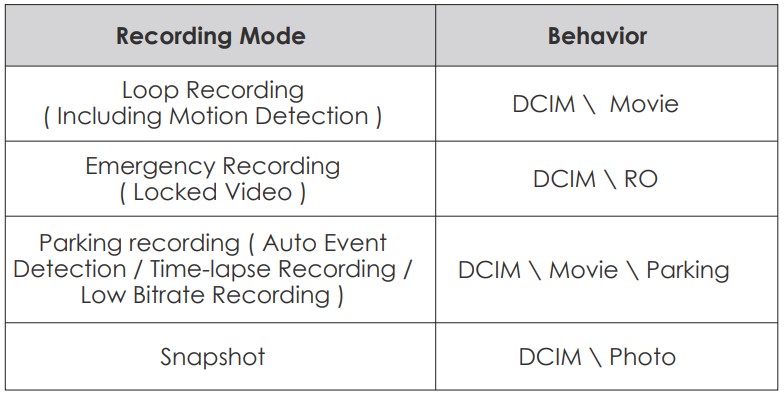
File Format Definition
Files recorded by the front camera, interior, and rear camera are saved separately.

Review and Control on Smartphone
Connect to Smartphone
The VIOFO app allows you to control your camera remotely by using a smartphone. Features include full camera control, live preview, playback, and video recording.
- Android Device
- IOS Device
- Connect VIOFO APP
APP Layout Overview
Choosing “Connect your camera” to use your phone to control the dashcam.

- Menu
- Downloaded Video
- VIOFO Official Facebook Page
- Official Support
- Firmware Update

- Interior Camera Live Video
- Rear Camera Live Video
- Front Camera Live Video
- Audio Recording Status
- Motion detection Status
- Switch Camera Video Source
- Take a Video Snapshot
- Go to Video File Lists
- Start / Stop Recording
- Go to System Settings
- Video File Lists
- Download Video Files
- Delete Video Files
Install Optional Accessories
Install CPL
The CPL (Circular Polarizing Lens) can be used to reduce reflections and glare from the window glass and road surfaces that can otherwise damage image quality, this works in the same way as polarized sunglasses, getting more saturated and beautiful video.

When installing the CPL, you need to align the white mark on the CPL with the corresponding mark on the camera.
Install Bluetooth Remote Control
The remote control has an adhesive mount on the back, choose a suitable location on your dashboard to stick it to. Power on the camera and then press the video lock button on the remote control for 3 seconds to pair it with the camera, the LED indicator on the remote will turn blue if successfully paired.

Systems Setting
The camera setup is available in the VIOFO App. Connect the App as above, stop recording, and then enter the settings menu.
Video Setting
- Recording Audio:
Turn on and off the microphone. This can also be changed during recording by pressing the button.
- Exposure:
Adjusting the value of the EV (Exposure Value) properly can create better footage under different light sources. It ranges from -2.0 to +2.0. You can adjust the EV for the front, interior, and rear cameras separately. The default is set at 0.0.
- WDR (Wide Dynamic Range):
On / Off. The dynamic range is the ratio of the brightest portion of the image to the darkest portion of the image. WDR enables the camera to deliver video with a near-perfect exposure in varying lighting situations.
- G-Sensor:
The G-sensor measures shock forces and locks the video recorded at the time. The settings from “low to high” determine the amount of force needed to lock the file from being overwritten. We recommend that you set it at low.
- Date Stamp:
On / Off. Imprint the time and date on the recorded video.
- Bitrate
You can set the bitrate for video. High bitrate may improve the quality and smoothness of the video, especially when recording fast motion or high-contrast scenes. Using high bitrate mode may decrease the amount of recording time available on your memory card. Using a low bitrate will save space and record for a longer time.
System Setting
- Wi-Fi Channel:
Off / 2.4GHz
- Time Zone:
Set the current time zone for GPS time and date calibration. Note: the time zone must be manually adjusted for daylight savings.
- Time Synchronization:
Time synchronization with mobile phone.
- Date Format:
You can choose the date format of the camera
- Boot delay:
The camera will boot a second delay when powered on. The settings are off / 5s / 10s.
- Parking Motion Detection:
Adjusts the sensitivity of the motion detection so minor motion caused by wind or rain doesn’t trigger a recording.
- Image Rotation:
Turn the image upside down. You can set the Front, Interior, and Rear camera image rotation separately.
- Notification Sounds:
Off / Button beep only / Startup sound only / All on. You can enable/disable the button and startup sounds.
- Reset Camera Settings:
Reset all settings to default values.
- Wi-Fi Name (SSID):
Change Wi-Fi name.
- Wi-Fi Password:
Change Wi-Fi Password. The Wi-Fi default password is 12345678.
- Custom Text Stamp:
Imprint the custom text on the recorded video.
- Car License Number:
Imprint the car number on the recorded video.
- Free Space on Card:
Show the remaining storage space on the microSD card.
Other
- App Version: Check the current firmware version of the APP.
- Firmware: Check the current firmware version of the camera.
Firmware Upgrade
Follow the instructions on this website to upgrade the firmware: (https://viofo.com/en/content/42-help-and-support/)
Note:
- Before using a microSD card to upgrade the firmware, formatting the card in the camera is necessary to ensure stable read and write operation.
- Do not unplug or power off the camera during a firmware upgrade, it may cause the camera to subsequently fail to boot.
Notice
FCC Statement
This equipment has been tested and found to comply with the limits for a Class B digital device, under part 15 of the FCC Rules. These limits are designed to provide reasonable protection against harmful interference in a residential installation. This equipment generates, uses, and can radiate radio frequency energy and, if not installed and used by the instructions, may cause harmful interference to radio communications.
However, there is no guarantee that interference will not occur in a particular installation. If this equipment does cause harmful interference to radio or television reception, which can be determined by turning the equipment off and on, the user is encouraged to try to correct the interference by one or more of the following measures:
- Reorient or relocate the receiving antenna.
- Increase the separation between the equipment and the receiver.
- Connect the equipment to an outlet on a circuit different from that to which the receiver is connected.
- Consult the dealer or an experienced radio / TV technician for help.
Caution:
Any changes or modifications to this device not explicitly approved by the manufacturer could void your authority to operate this equipment. This device complies with part 15 of the FCC Rules. Operation is subject to the following two conditions:
- This device may not cause harmful interference.
- This device must accept any interference received, including interference that may cause undesired operation.
Customer Service
Product Registration Program
VIOFO also has a Product Registration Program to help customers extend their warranty by 6 months. Visit www.viofo.com and register your new product to extend the warranty from 12 months to 18 months.
Your Opinion Matters
If you have any thoughts on how we can do even better, connect with us today at support@viofo.com.
Video Sharing
Share videos caught on the VIOFO camera with us. Let’s enjoy your newfound together! Gain a chance to get a mysterious gift at marketing@viofo.com.
How to Contact Us?
- Submit a ticket at support.viofo.com
- Live chat box at www.viofo.com
- support@viofo.com
- www.facebook.com/viofo.world
- +86 755 8526 8909 (CN)
- Mon-Fri 9 am – 6 pm
FAQs about VIOFO T130 3 Channel Dash Cam
What is Viofo’s exposure value?
Under various lighting circumstances, you can improve recording performance by adjusting the EV (Exposure Value). Our suggested value is 0.0, and the range is from -2.0 to +2.0. The A139 Pro can produce video with almost perfect exposure in a variety of lighting conditions thanks to HDR.
What parking options work best for Viofo?
An event recording is started when the G-sensor notices significant or abrupt movement (such an accident or collision). We advise setting it to High sensitivity for parking mode recording. In order to prevent insignificant motion brought on by wind or rain from starting a recording, this modifies the detecting sensitivity.
What does Viofo’s GPS module do?
The captured movies contain location information thanks to a GPS gadget. To view videos on your computer and see your position and speed, please utilize the “Dashcam Viewer” program.
How much memory space does a dash camera need?
Usage Time – Typically, 6GB is used for every hour of 1080p recording. A 64GB card or around 60GB of storage would be required for two hours of driving per day, five days per week. Dash cameras typically capture between 30 and 60 frames per second.
What parking options are there on Viofo?
The menu offers three parking modes: Low bitrate, Time-lapse, and Auto-event recognition.
Which parking angle is ideal?
Parking spaces perpendicular (90 degrees) to the aisles offer the most effective design for two-way traffic flow. As the parking angle falls, the efficiency declines.
What is the GPS module’s frequency?
A GPS receiver can identify its own position by analyzing signals it receives from the satellites with an error of less than 10 meters. L1, at 1575.42 MHz, and L2, at 1227.6 MHz are the minimum number of carrier frequencies that all GPS satellites broadcast on; more recent satellites additionally transmit on L5 at 1176 MHz.
A sensor, the GPS module?
GPS sensors are receivers with antennas that employ a satellite-based navigation system to give location, velocity, and time data from a network of 24 satellites in orbit around the earth.
What distinguishes a GPS module from a GPS receiver?
In other words, each visible satellite transmits a timestamp to the GPS module, along with information about its location in the sky and other information. The GPS receiver now has the distance to each satellite in its field of view.
For more manuals by Viofo, Visit Manualsdock


